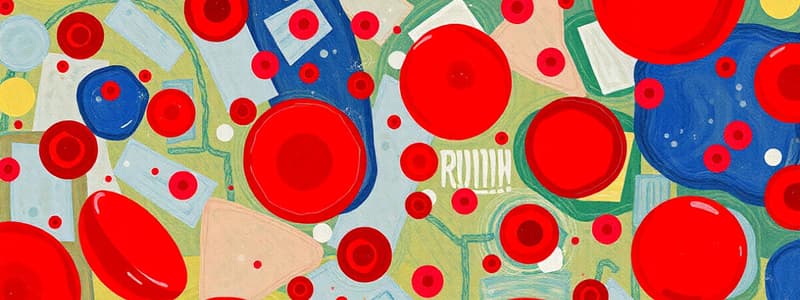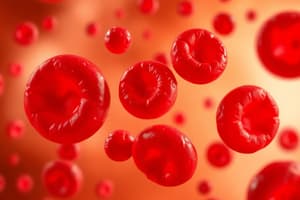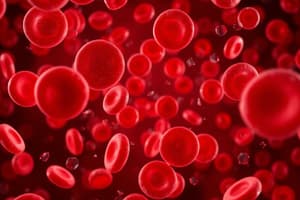Podcast
Questions and Answers
If a patient's blood test reveals a significantly lower than normal erythrocyte count, which bodily function would be MOST affected?
If a patient's blood test reveals a significantly lower than normal erythrocyte count, which bodily function would be MOST affected?
- Regulation of body temperature.
- Transportation of oxygen. (correct)
- Transportation of hormones.
- Prevention of blood loss.
A researcher is analyzing a blood sample and finds a higher than normal proportion of plasma. Which of the following could explain this observation?
A researcher is analyzing a blood sample and finds a higher than normal proportion of plasma. Which of the following could explain this observation?
- The patient has a bleeding disorder.
- The patient is severely dehydrated.
- The patient has an active bacterial infection.
- The patient is experiencing significant blood loss. (correct)
How does the unique structure of erythrocytes directly contribute to their primary function of oxygen transport?
How does the unique structure of erythrocytes directly contribute to their primary function of oxygen transport?
- The rigid cell wall prevents the cell from deforming as it passes through capillaries.
- The biconcave shape increases surface area for gas exchange, and the lack of a nucleus maximizes space for hemoglobin. (correct)
- The presence of a large nucleus allows for efficient DNA replication and protein synthesis.
- The abundance of organelles provides the energy necessary for active transport of oxygen.
A single hemoglobin molecule can bind to four oxygen molecules due to the presence of four globin chains, each containing what?
A single hemoglobin molecule can bind to four oxygen molecules due to the presence of four globin chains, each containing what?
Following a routine blood test, a patient is informed that they have an elevated number of eosinophils. This most likely indicates that the patient is experiencing which condition?
Following a routine blood test, a patient is informed that they have an elevated number of eosinophils. This most likely indicates that the patient is experiencing which condition?
Histamines are released by basophils and cause blood vessels to dilate. What is the MOST likely reason for the vasodilation caused by histamine release?
Histamines are released by basophils and cause blood vessels to dilate. What is the MOST likely reason for the vasodilation caused by histamine release?
A patient undergoing chemotherapy experiences a significant drop in their red blood cell count. Which of the following processes is MOST directly affected by this side effect of chemotherapy?
A patient undergoing chemotherapy experiences a significant drop in their red blood cell count. Which of the following processes is MOST directly affected by this side effect of chemotherapy?
What would be the immediate consequence if hemostasis did not occur?
What would be the immediate consequence if hemostasis did not occur?
Flashcards
Functions of Blood
Functions of Blood
Transports oxygen, waste, and hormones; regulates body temperature, pH, and fluid volume; prevents infection and blood loss.
Formed Elements of Blood
Formed Elements of Blood
Red blood cells (erythrocytes), white blood cells (leukocytes) and platelets, and plasma.
Composition of Whole Blood
Composition of Whole Blood
Plasma (55%), White blood cells and platelets (1%), Red blood cells (44%).
Erythrocyte Structure & Function
Erythrocyte Structure & Function
Signup and view all the flashcards
Hemoglobin Characteristics
Hemoglobin Characteristics
Signup and view all the flashcards
Neutrophil Function
Neutrophil Function
Signup and view all the flashcards
Eosinophil Function
Eosinophil Function
Signup and view all the flashcards
Hematopoiesis
Hematopoiesis
Signup and view all the flashcards
Study Notes
- The functions of blood include transporting oxygen, waste, and hormones
- Blood also regulates body temperature, pH, and fluid volume and prevents infection and blood loss
- Formed elements in the blood are red blood cells (erythrocytes), white blood cells and platelets (leukocytes), and plasma
- Whole blood is composed of about 55% plasma, 1% white blood cells and platelets, and 44% red blood cells
- The structure of erythrocytes allows for greater surface area and can move smoothly due to its round shape
- Erythrocytes lack nuclei and have few organelles, so they conserve oxygen
Hemoglobin Protein
- Hemoglobin contains 4 globin chains
- Each hemoglobin molecule can hold 4 oxygen molecules
- Hemoglobin holds an iron atom
Erythrocytes vs. Leukocytes
- Erythrocytes outnumber leukocytes 1,000 to 1
- Mature erythrocytes don't contain nuclei, while leukocytes always contain nuclei
- Erythrocytes live for only 100-120 days, while leukocytes live for a few days, but some can live for years
- Erythrocytes are confined to the bloodstream, while leukocytes flow through plasma
- Erythrocyte concentration in blood remains fairly constant
Leukocytes Classifications
- Neutrophils engulf and destroy foreign bacteria and are the most common leukocyte, increasing during infection
- Eosinophils have two-lobed nuclei, kill parasitic worms ingested in food, and lessen allergic reactions
- Basophils release histamines, which dilate blood vessels for other leukocytes to reach infections or allergies
- Lymphocytes have a large, spherical nucleus and are mostly found in lymph nodes rather than the bloodstream
- Monocytes have a kidney-shaped nucleus and become macrophages when they enter tissue, attacking viruses and bacteria
Hematopoiesis
- Hematopoiesis takes place in the bone marrow of grown adults
- It starts with a hemocytoblast stem cell
- Hematopoiesis is stimulated by hormones
Hemostasis
- Hemostasis is the process of stopping bleeding
- Steps of hemostasis include blood vessel contraction
- Platelets are chemically attracted to the wounded epithelium and stick together
- Injured tissue releases tissue factor that interacts with platelets, causing the production of thrombin
- Chemical properties of hemostasis: Platelets are attracted to the epithelium, and injured tissue releases thrombin
- Physical properties of hemostasis: Blood vessel contraction
- A dislodged thrombus is known as an embolus
Studying That Suits You
Use AI to generate personalized quizzes and flashcards to suit your learning preferences.
Related Documents
Description
The functions of blood include transportation of oxygen, waste, and hormones. It also regulates body temperature and prevents infection. Blood is composed of plasma, white blood cells, platelets and red blood cells, which carry oxygen via hemoglobin.




